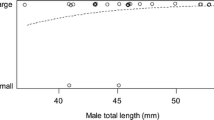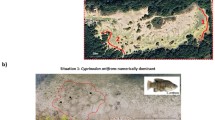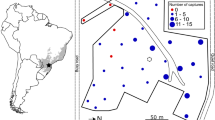Abstract
Despite growing evidence for plasticity in the mating patterns of nest-holding animals in relation to the changes in nest abundance, the effects of aggressive interaction by dominant males on nest availability for conspecific rivals remains unclear. To quantify the effects of male–male competition on nest-site choice and mating success of the male Japanese fluvial sculpin Cottus pollux, we conducted experiments on 5 males from different 5 size classes under both sufficient and shortage nest-abundance conditions. Nest-choice experiments showed that both male size class and nest-abundance condition had significant effects on the nesting rates of males. Following the nest-choice experiments, 10 gravid females were added in the experimental tanks. Mating experiments revealed that male size, nesting rate before addition of females, and the number of courtship attempts on females were valid variables of male mating success, regardless of nest-abundance conditions. After achieving initial mating success, the largest nesting male exhibited more frequent aggressive interaction with other conspecific males than he did before obtaining eggs in his nest. Our results suggest that size-mediated dominance and aggressive behavior of males may disrupt nest acquisition of other conspecific males, and may consequently result in extreme variation in mating success among males even under sufficient nest-abundance conditions.




Similar content being viewed by others
References
Andersson M (1994) Sexual selection. Princeton University Press, New Jersey
Brown L, Downhower JF (1982) Polygamy in the mottled sculpins (Cottus bairdi) of southwestern montana (Pisces: Cottidae). Can J Zool 60:1973–1980
Downhower JF, Brown L (1980) Mate preferences of female mottled sculpins, Cottus bairdi. Anim Behav 28:728–734
Emlen S, Oring LW (1977) Ecology, sexual selection, and the evolution of mating systems. Science 197:215–223
Forsgren E, Kvarnemo C, Lindström K (1996) Mode of sexual selection determined by resource abundance in two sand goby populations. Evolution 50:646–654
Gauthier G, Smith JNM (1987) Territorial behaviour, nest-site availability, and breeding density in buffleheads. J Anim Ecol 56:171–184
Goto A (1982) Reproductive behaviour of a river sculpin, Cottus nozawae. Jpn J Ichthyol 28:453–457
Goto A (1987) Polygyny in the river sculpin, Cottus hangiongensis (Pisces: Cottidae), with special reference to male mating success. Copeia 1987:32–40
Goto A (1990) Alternative life-history styles of Japanese freshwater sculpins revisited. Environ Biol Fish 28:101–112
Karino K (1996) Study methods of sexual selection in fishes—field observations, experiments and analyses. Jpn J Ichthyol 43:1–11
Kraak SBM (1996) A quantitative description of the reproductive biology of the Mediterranean blenny Aidablennius sphynx (Teleostei, Blenniidae) in its natural habitat. Environ Biol Fish 46:329–342
Lehtonen TK, Rintakoski S, Lindström K (2007) Mate preference for multiple cues: interplay between male and nest size on the sand goby, Pomatoschistus minutus. Behav Ecol 18:696–700
Lindström K (1988) Male–male competition for nest sites in the sand goby, Pomatoschistus minutus. Oikos 53:67–73
Lindström K (1992) The effect of resource holding potential, nest size and information about resource quality on the outcome of intruder-owner conflicts in the sand goby. Behav Ecol Sociobiol 30:53–58
Lindström K (1993) Male size and parental care in the sand goby, Pomatoschistus minutus. Ethol Ecol Evol 5:97–106
Lugli M, Bobbio L, Torricelli P, Gandolfi G (1992) Breeding ecology and male spawning success in two hill-stream populations of the freshwater goby, Padogobius martensi. Environ Biol Fish 35:37–48
Magnhagen C, Kvarnemo L (1989) Big is better: the importance of size for reproductive success in male Pomatoschistus minutus (Pallas) (Pisces, Gobiidae). J Fish Biol 35:755–763
Mori S (1993) The breeding system of the three spined stickleback Gasterosteus aculaeatus (forma leiura) with special reference to spatial and temporal patterns of nesting activity. Behaviour 126:97–124
Morris D (1954) The reproductive behaviour of the river bullheds (Cottus gobio) with special reference to the fanning activity. Behaviour 7:1–32
Mousseau TA, Collins NC (1987) Polygyny and nest site abundance in the slimy sculpin (Cottus cognatus). Can J Zool 65:2827–2829
Natsumeda T (1998a) Life history and reproductive ecology of the Japanese fluvial sculpin, Cottus pollux, with special reference to spatial-temporal availability of nest resources. PhD thesis, Kyoto University
Natsumeda T (1998b) Size-assortative nest choice by the Japanese fluvial sculpin in the presence of male–male competition. J Fish Biol 53:33–38
Natsumeda T (2001) Space use by the Japanese fluvial sculpin, Cottus pollux, related to spatio-temporal limitations in nest resources. Environ Biol Fish 62:393–400
Natsumeda T (2005) Biotic and abiotic influences on nest-hatching outcome in the Japanese fluvial sculpin, Cottus pollux. Environ Biol Fish 74:349–356
Natsumeda T (2007) Variation in age at first reproduction of male Japanese fluvial sculpin induced by the timing of parental reproduction. J Fish Biol 70:1378–1391
Natsumeda T, Kimura S, Nagata Y (1997) Sexual size dimorphism, growth and maturity of the Japanese fluvial sculpin, Cottus pollux (large egg types) in the Inabe River, Mie Prefecture, central Japan. Ichthyol Res 44:43–50
Newton I (1994) The role of nest sites in limiting the numbers of hole-nesting birds: a review. Biol Conserv 70:265–276
Östlund S (2000) Are nest characters of importance when choosing a male in the fifteen-spined stickleback (Spinachia spinachia)? Behav Ecol Sociobiol 48:229–235
R Development Core Team (2011) R: a language and environment for statistical computing. R Foundation for Statistical Computing, Vienna
Savage T (1963) Reproductive behavior of the mottled sculpin, Cottus bairdi Girard. Copeia 1963:317–325
Shuster SM, Wade MJ (2003) Mating systems and strategies. Princeton University Press, New Jersey
Stearns SC (1992) The evolution of life histories. Oxford University Press, Oxford
Takahashi D (2008) Life-history variation in relation to nest site abundance in males of the freshwater goby Tridentiger brevispinis. Ecol Freshw Fish 17:71–77
Village A (1983) The role of nest-site availability and territorial behaviour in limiting the breeding density of kestrels. J Anim Ecol 52:337–350
Zuur AF, Ieno EN, Walker NJ, Saveliev AA, Smith GM (2009) Mixed effects models and extensions in ecology with R. Springer, New York
Acknowledgments
We sincerely thank Drs Y. Nagata, M. Hori, T. Narita, M. Kohda, K. Karino and S. Awata for their critical readings and advice on the early version of this manuscript; the Kodamas for providing fish farm ponds and a pleasant room during the experimental study; and T. Ito and Y. Shimizu for providing valuable information during the field survey. The experiments carried out in this study comply with the current laws in Japan.
Author information
Authors and Affiliations
Corresponding author
About this article
Cite this article
Natsumeda, T., Mori, S. & Yuma, M. Size-mediated dominance and aggressive behavior of male Japanese fluvial sculpin Cottus pollux (Pisces: Cottidae) reduce nest-site abundance and mating success of conspecific rivals. J Ethol 30, 239–245 (2012). https://doi.org/10.1007/s10164-011-0316-7
Received:
Accepted:
Published:
Issue Date:
DOI: https://doi.org/10.1007/s10164-011-0316-7




